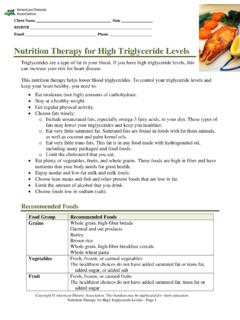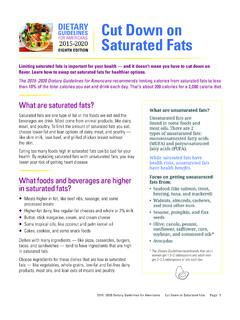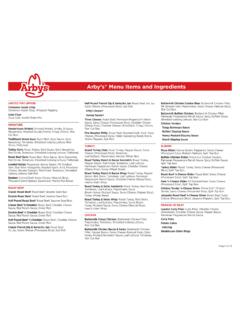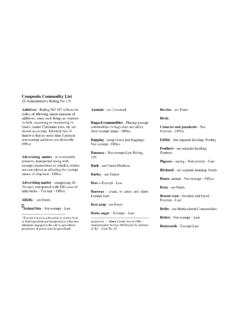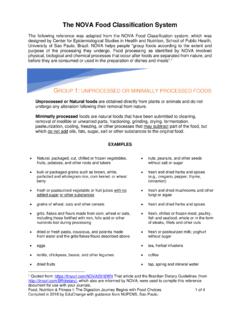Transcription of The Lipids: Triglycerides, Phospholipids and Sterols
1 Chapter 5 The Lipids-Triglycerides, Phospholipids , and Sterols The Lipids: Triglycerides, Phospholipids and Sterols The Lipid Family Triglycerides (fats and oils) Predominate in the body (99%) and in foods (95%) Composed of Carbon, Hydrogen and Oxygen 9 kcalories per gram Phospholipids (such as lecithin) Sterols (such as cholesterol) Chemist s View of Fatty Acids and Triglycerides Triglycerides 1. Composed of glycerol + 3 fatty acids 2. Fatty acids may be 4-24 carbons long Even numbers 18 carbons fatty acids most common 3.
2 Saturated or Unsaturated monounsaturated or polyunsaturated 4. Omega-3 and Omega-6 fatty acids are of importance in nutrition. 5. Essential Fatty acids include: Omega-3-linolenic Omega-6 linoleic What is a Fatty Acid? Composed of a chain of carbon atoms with hydrogen atoms attached Have an acid group at one end and a methyl group at the other end. Usually even numbers of carbons A Fatty Acid Stearic acid, an 18- carbon saturated fatty acid. Stearic acid (simplified structure).
3 Fatty Acids Chain Length Long-chains are 12 - 24 carbons in length common in meats, fish and vegetable oils 18-carbon fatty acids are abundant in food Medium chains are 6 - 10 carbons coconut and palm oils Short chains are < 6 carbons dairy products Stearic acid The Number of Double Bonds Degree of Saturation Saturated fatty acid: contains the maximum possible number of hydrogen atoms No double bonds Stearic acid; 18 carbon saturated fatty acid The Number of Double Bonds Unsaturated fatty acid: Has some hydrogen atoms missing and therefore has at least 1 double bond Monounsaturated fatty acid: has 1 double bond (missing 2 hydrogen atoms) oleic acid found in olive oil and canola 18 carbon monounsaturated fatty acid.
4 Oleic The Number of Double Bonds Polyunsaturated fatty acid: has 2 or more double bonds linoleic acid has 2 linolenic acid found in soybean oil has 3 18 carbon polyunsaturated fatty acid linoleic acid found in corn, safflower, sunflower, and soybean oils Stearic acid, an 18-carbon saturated fatty acid Oleic acid, an 18-carbon monounsaturated fatty acid Linoleic acid, an 18-carbon polyunsaturated fatty acid Table 5-1, p. 135 18-Carbon Fatty Acids Location of the Double Bonds Omega Number Polyunsaturated acids are identified by the location of their double bond.
5 The omega number indicates the position of the 1st double bond in a fatty acid Counting from the CH3 group (methyl group) Omega-3 and Omega-6 Fatty Acids Compared Chemist s View of Fatty Acids and Triglycerides Triglycerides 1 glycerol molecule 3 fatty acids Formed via a condensation reaction Usually contains a mixture of fatty acids (saturated and unsaturated) Triglyceride Formation Condensation Reactions A Mixed Triglyceride fatty acids (18-c saturated) stearic acid Glycerol fatty acids(18-c monounsaturated) oleic fatty acids (18-c polyunsaturated) linoleic Characteristics of solid fats and oils Degree of Unsaturation Firmness Unsaturated.
6 Liquid at room temperature Polyunsaturated vegetable oils Vegetable oils make up much of the added fat in the diet Fast-food chains use them for frying Food manufacturers add them to processed foods Characteristics of solid fats and oils Degree of saturation influences firmness at room temperature More saturated fats are solid at room temperature Animal fats (fat on the meat and fat in dairy) Tropical Oils palm oil, palm kernel oil, coconut oil, cocoa butter Softer due to shorter carbon chain Fig.
7 5-4, p. 133 Saturated fatty acids tend to stack together. Consequently, saturated fats tend to be solid (or more firm) at room temperature. This mixture of saturated and unsaturated fatty acids does not stack neatly because unsaturated fatty acids bend at the double bond(s). Consequently, unsaturated fats tend to be liquid (or less firm) at room temperature. Double bond Saturated and Unsaturated Compared Fatty Acid Composition of Common Food Fats Stability Fat becomes spoiled when exposed to oxygen Particularly polyunsaturated Saturated fats are most resistant to oxidation To prevent rancidity food companies: Use air-tight seals and refrigeration Antioxidants are added - BHA, BHT, Vitamin E Hydrogenation Characteristics of solid fats and oils What is Hydrogenation?
8 The process of adding hydrogen to unsaturated fatty acids to make the fat more solid and resistant to the chemical change of oxidation Protects against oxidation Alters texture of the food by making liquid vegetable oils more solid Produces trans fatty acids Characteristics of solid fats and oils Hydrogenation Double bonds carry a slightly negative charge and readily accept positively charged hydrogen. Most often fat is partially hydrogenated, creating a trans-fatty acid.
9 Cis-and Trans-Fatty Acids Compared Characteristics of solid fats and oils Hydrogenated Vegetable Oil Prevents spoilage of unsaturated fats Hydrogenated oil is used in frying Can be heated to high temperature Easy to handle, easy to spread Once fully hydrogenated, an oil loses both its unsaturated character and health benefits The stick margarines may contain almost 50% of their fat as trans fat Phospholipids Phospholipids are soluble in both water and fat Cell membranes Help lipids move across cell membranes, such as vitamins, and hormones Emulsifiers-keep fat suspended in body fluids Lecithin Phospholipids Phospholipids in food Found in foods such as eggs, liver, soybeans, wheat germ.
10 Peanuts Used in food industry as emulsifiers in foods such as mayonnaise and salad dressings and candy bars Sterols Sterols in Food: Most common one is cholesterol; Found only in foods of animal origin Meat, eggs, fish and poultry, dairy Plant Sterols (phytosterols) Naturally found plants but in very low levels Plant Sterols block cholesterol absorption Plant Sterols have been added to common foods such as vegetable oil spreads, dairy drinks, snack bars Sterols Roles of Sterols : Cholesterol ( component of cell membranes) Made in the liver Bile acids Sex hormones Adrenal hormones Vitamin D Cholesterol can be used as the starting materiel to make these compounds Cholic Acid and the Sex Hormones Cholesterol Content of Common Foods Lipid Digestion In the GI Tract Fat Watery GI juices Fat Fig.
